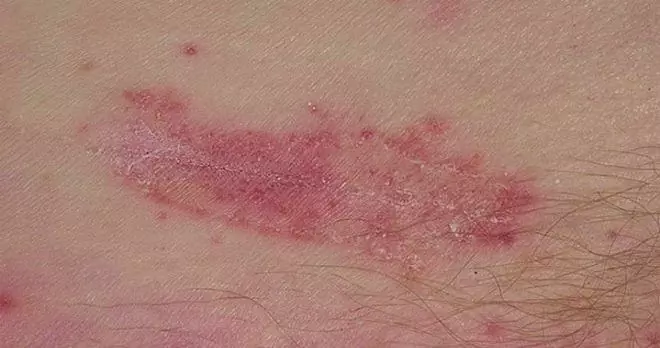- Author Rachel Wainwright [email protected].
- Public 2023-12-15 07:39.
- Last modified 2025-11-02 20:14.
Skin atrophy
The content of the article:
- Causes and risk factors
- Forms of the disease
- Symptoms
- Diagnostics
- Treatment
- Possible complications and consequences
- Forecast
- Prevention
Skin atrophy is a group of chronic skin diseases of an irreversible nature, manifested by a decrease in the number and volume of its components (epidermis, dermis, subcutaneous fat) with a weakening or termination of their function due to insufficient nutrition and a decrease in metabolic intensity.
With atrophic changes in the skin, there is a sharp decrease in elastic fibers, which leads to flabbiness and deterioration of elasticity.
The skin of elderly patients is more often subject to atrophic changes; the process in this case is physiological, takes a long time and is due to age-related tissue involution. But sometimes atrophy can develop rapidly, affecting young people or even children and adolescents.
Synonym: atrophoderma.

Skin atrophy is irreversible
Causes and risk factors
Skin atrophy can be physiological or pathological. Physiological atrophy is not considered a disease and is caused by natural aging processes.
The causes of pathological atrophy are most often:
- inflammatory diseases (of bacterial, fungal and viral nature);
- hormonal shifts;
- diseases of the central nervous system;
- autoimmune processes;
- traumatic mechanical impact;
- long-term therapy with topical preparations containing glucocorticoid hormones;
- metabolic diseases;
- exposure to harsh chemicals;
- radiation damage;
- chronic excessive insolation;
- genetic defect.
Despite the fact that many causal factors have been established that can lead to atrophy of the skin, it is sometimes not possible to reliably determine the cause of the disease.
Forms of the disease
Depending on the origin, hereditary and acquired skin atrophy is distinguished.
In connection with previous diseases, atrophy can be of a primary nature (independent pathology) or secondary, that is, it can develop against the background of previous endo- or exogenous pathological conditions.
Forms of skin atrophy:
- senile (physiological);
- spotted (anetoderma);
- worm-like (scarring acne erythema, reticular symmetrical atrophoderma of the face, worm-like atrophoderma of the cheeks);
- neurotic ("shiny skin");
- progressive facial hemiatrophy (Parry-Romberg);
- atrophoderma of Pasini - Pierini (superficial scleroderma, flat atrophic morphea);
- lipoatrophy;
- panatrophy;
- idiopathic progressive skin atrophy (chronic atrophic acrodermatitis, chronic atrophic acrodermatitis of Herxheimer - Hartmann, Pick erythromyelosis);
- striped;
- white (Milian's atrophy);
- kraurosis of the vulva;
- poikiloderma ("mesh skin", or "variegated skin").

White skin atrophy (Milian's atrophy)
According to the degree of distribution of atrophic changes, atrophy is:
- diffuse - spreads to various parts of the body, is diffuse in nature without clear localization;
- disseminated - zones of atrophy are located in islands among unchanged areas of the skin;
- local - limited changes are localized on a specific part of the body.
Symptoms
Each of the forms of atrophoderma has specific symptoms, a characteristic course and localization of the pathological process. However, the varieties of the disease have common features:
- color change of varying intensity (from brown to whitish color, transparency);
- thinning of the skin of the type of tissue paper and (to varying degrees) subcutaneous fat;
- translucent vascular network, spider veins, spots, punctate hemorrhages;
- dry skin;
- smoothness of the skin pattern;
- foci of atrophy - "sunken", are located below the level of unchanged skin;
- a significant decrease in the elasticity and turgor of the skin (flaccid, flabby appearance);
- fine folding, wrinkling of the affected areas.
The foci of atrophy are easily injured, they can undergo malignant transformation.

Skin atrophy is characterized by dryness, thinning of the skin, a significant decrease in elasticity
As a rule, atrophoderma has a long (lifelong) chronic course with episodes of remission and exacerbation: old foci gradually increase in size, new zones of atrophy may appear. Sometimes the process stabilizes spontaneously.
Diagnostics
Diagnosis is based on an objective examination of the patient and a pathological examination of a biopsy specimen of the affected skin (thinning of the epidermis and dermis, degeneration of collagen and elastic fibers, lymphocytic infiltrate of the dermis are established).
Treatment
Effective treatment of skin atrophy (especially a complete cure) at the current level of development of medicine is not possible.
Patients are recommended symptomatic remedies and supportive measures to stabilize the process and slow down the progression of the disease:
- vitamin therapy;
- anti-fibrotic drugs;
- local moisturizers;
- physiotherapy procedures;
- Spa treatment;
- balneotherapy;
- medicinal baths.

As part of the complex therapy of skin atrophy, balneotherapy and spa treatment are used
Possible complications and consequences
Skin atrophy can have the following complications:
- malignancy of atrophic areas;
- trauma;
- uncontrolled progression;
- the occurrence of cosmetic defects (scarring, foci of baldness, nail damage, deep damage to soft tissues, etc.).
Forecast
The prognosis for recovery is unfavorable, since the disease is lifelong.
In the majority of cases, the work and social activity of patients is not limited, the quality of life does not suffer, except for cases of damage to the skin of the face, limbs and scalp with the formation of cosmetic defects.
Prevention
There is no primary prevention of atrophoderma. Secondary prevention consists in the timely treatment of diseases that can lead to atrophy of the skin.

Olesya Smolnyakova Therapy, clinical pharmacology and pharmacotherapy About the author
Education: higher, 2004 (GOU VPO "Kursk State Medical University"), specialty "General Medicine", qualification "Doctor". 2008-2012 - Postgraduate student of the Department of Clinical Pharmacology, KSMU, Candidate of Medical Sciences (2013, specialty "Pharmacology, Clinical Pharmacology"). 2014-2015 - professional retraining, specialty "Management in education", FSBEI HPE "KSU".
The information is generalized and provided for informational purposes only. At the first sign of illness, see your doctor. Self-medication is hazardous to health!






